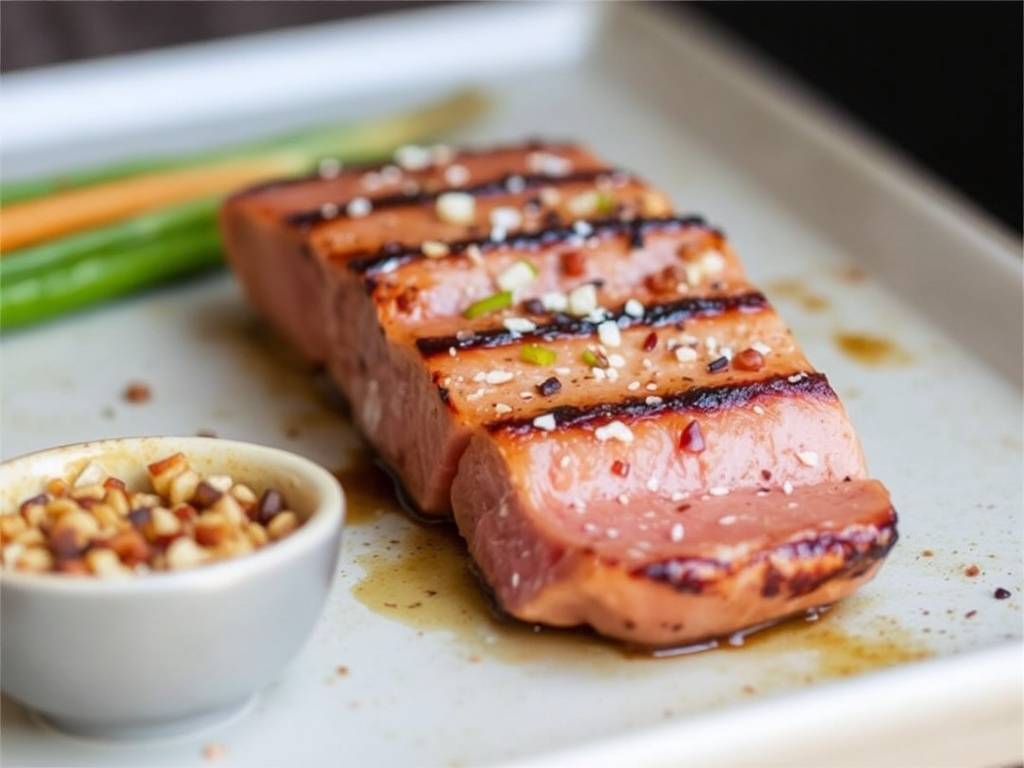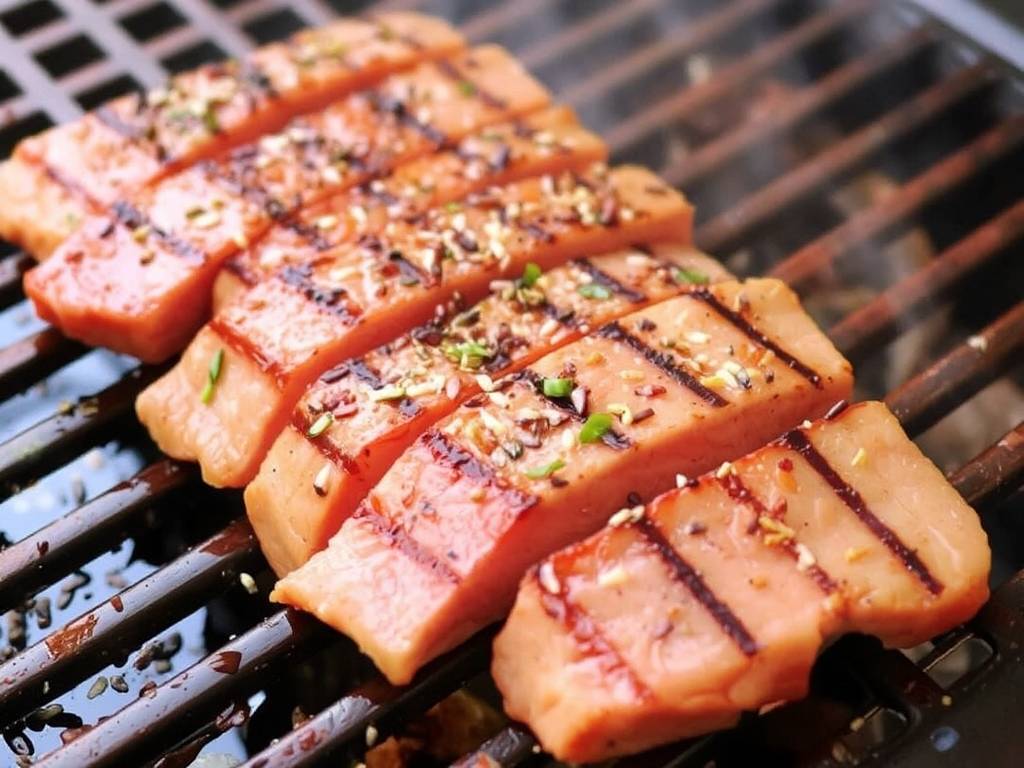The Ultimate Guide to Perfectly Grilled Tuna with Salt and Pepper
There's something magical about the simplicity of perfectly grilled tuna. When you start with a beautiful piece of fresh tuna and use nothing more than high-quality salt and freshly cracked pepper, you allow the fish's natural, robust flavor to truly shine. This isn't about hiding behind heavy sauces or complicated marinades. This is about mastering a few fundamental techniques to create a restaurant-quality meal on your own grill.
Many home cooks feel intimidated by grilling tuna, fearing they'll overcook it into a dry, chalky disappointment. But I'm here to guide you through every single step, from selecting the right cut to achieving that coveted seared crust and rare, succulent center. We will explore not just the "how," but the "why" behind each step, ensuring you become confident in grilling tuna steaks with just salt and pepper.

Choosing Your Tuna: The Foundation of Flavor
The journey to a perfect grilled tuna steak begins at the market. Your choice of fish is the single most important factor. Look for firm, glossy steaks with a vibrant color and a clean, ocean-fresh smell. Avoid any pieces that look dull, dry, or have a strong, fishy odor.
For grilling, you want a meaty, dense variety of tuna. The best options are:
- Ahi Tuna (Yellowfin): This is the most common choice for grilling. It has a deep red color, a firm texture, and a mild, meaty flavor that stands up beautifully to the high heat of the grill.
- Bluefin Tuna: If you can find it and afford it, Bluefin is the ultimate luxury. It's incredibly rich, fatty, and flavorful, often compared to a fine steak.
- Bigeye Tuna: Similar to Ahi, Bigeye has a slightly higher fat content, which makes it exceptionally moist and forgiving on the grill.
When you're at the fish counter, don't be shy. Ask for "thick-cut tuna steaks for grilling." A thickness of 1 to 1.5 inches is ideal. This gives you enough mass to create a fantastic sear on the outside while keeping the inside beautifully rare. A thin steak will cook through before you can even get a good crust.
The Art of the Seasoning: Salt and Pepper Mastery
The title of this guide says it all: salt and pepper. But not all salts and peppers are created equal. This simple combination, when chosen wisely, will elevate your tuna from good to extraordinary.
- The Salt: Ditch the fine, iodized table salt. For the best results, use a flaky sea salt like Maldon Sea Salt or a coarse kosher salt. These types have a clean, pure taste and a delightful crunch that adds texture. The larger crystals also adhere better to the surface of the tuna. The key to seasoning tuna for the grill is to be generous. Salt not only adds flavor but also helps draw a little moisture to the surface, which promotes better browning.
- The Pepper: Please, I beg of you, put down the pre-ground pepper canister. The flavor of pre-ground pepper is a shadow of what it could be. Invest in a good pepper mill and whole black peppercorns. Freshly cracked black pepper has a vibrant, spicy, and aromatic quality that is completely transformative. For a more complex flavor, you can use a mix of black, white, and pink peppercorns.
About 30 minutes before you plan to grill, take the tuna steaks out of the refrigerator. Letting them come to room temperature is a critical step for even cooking on the grill. A cold steak straight from the fridge will seize up on the grill and cook unevenly, leaving you with an overcooked exterior and a cold, raw center.
Pat the steaks completely dry with paper towels. A dry surface is non-negotiable for achieving a perfect sear. Now, generously coat all sides with your coarse salt and a heavy crack of fresh black pepper, pressing gently to make sure the seasoning adheres.
Prepping the Grill: Your Culinary Canvas
Whether you're using a gas grill or a charcoal grill, the principle is the same: you need intense, direct, high heat. Tuna cooks quickly, and we want to sear the outside rapidly without cooking the inside.
- For a Gas Grill: Preheat your grill on high for at least 10-15 minutes with the lid closed. You're aiming for a temperature of 450-500°F (230-260°C).
- For a Charcoal Grill: Build a hot fire and let the coals become covered with white-gray ash. You should be able to hold your hand about 5 inches above the grill grate for only 1-2 seconds.
This high heat is essential for the Maillard reaction—the chemical process that creates that delicious, brown, flavorful crust we all love. To prevent sticking, carefully oil the hot grill grates. Fold a paper towel, dip it in a high-smoke-point oil like canola, grapeseed, or avocado oil, and, using tongs, wipe it across the grates. Do this just before you place the fish on the grill.
The Grilling Process: A Dance of Heat and Time
This is where it all comes together. Your tuna is seasoned, your grill is screaming hot, and you're ready to go. Here is the definitive method for how to grill tuna steak without overcooking.

- Place the Steaks: Lay the tuna steaks on the hot grill at a 45-degree angle to the grates. This isn't just for looks; it creates those beautiful, professional cross-hatch grill marks.
- Sear the First Side: Do not move the steak! Let it sear undisturbed for 1.5 to 2 minutes. The exact time will depend on the thickness of your steak and the heat of your grill. You'll know it's ready to flip when the edges of the steak begin to turn opaque and it releases easily from the grates. If it sticks, it needs more time.
- Flip and Finish: Using a thin, wide spatula, flip the steaks. For those classic cross-hatch marks, give the steak a 90-degree turn on the same side before flipping, but if you prefer simplicity, a single flip is just fine. Sear the second side for another 1 to 1.5 minutes for rare, or 2-2.5 minutes for medium-rare.
Remember, we are essentially searing the tuna, not slow-cooking it. The goal is a crust that is dark and speckled with pepper, and an interior that is still deep red and cool in the very center. This is the secret to achieving a seared crust on tuna.
Doneness and Resting: The Final, Crucial Steps
Unlike a beef steak, you cannot reliably check the doneness of tuna by touch. The best method is to use the power of observation.
- Rare: The interior will be about 75% red, with a warm center. The outside is seared, and the very center is cool and red. This is how most chefs prefer it.
- Medium-Rare: The interior is about 50% pink, and the center is warm. This is a great option for those who are new to rare fish.
- Medium and Beyond: I strongly advise against cooking tuna beyond medium. The delicate proteins tighten dramatically, squeezing out all the moisture and leaving you with a dry, tough piece of fish.
As soon as the tuna comes off the grill, the most important step begins: resting. Transfer the steaks to a clean plate or a cutting board and let them rest for 3-5 minutes. This allows the muscle fibers to relax and reabsorb the juices. If you cut into it immediately, all those precious juices will run out onto the plate, leaving the tuna dry.
Serving and Enjoying Your Masterpiece
After resting, your perfectly grilled salt and pepper tuna is ready. You can serve it as a whole steak or slice it against the grain into ½-inch thick slices, fanning them out on a plate to showcase the beautiful gradient from the seared crust to the ruby-red center.
This simple, elegant dish is incredibly versatile. Serve it atop a fresh green salad with a citrus vinaigrette, alongside grilled asparagus or zucchini, or with a scoop of jasmine rice. A final drizzle of high-quality extra virgin olive oil or a squeeze of fresh lemon juice is all the accompaniment it needs.
By following this comprehensive guide, you have learned more than just a recipe. You've learned the principles of selecting fish, the impact of proper seasoning, the science of high-heat grilling, and the art of patience through resting. You are now equipped to confidently create a stunning, healthy, and delicious easy grilled tuna recipe anytime the craving strikes. So fire up that grill, and get ready to impress yourself and your guests. Happy grilling






发表评论